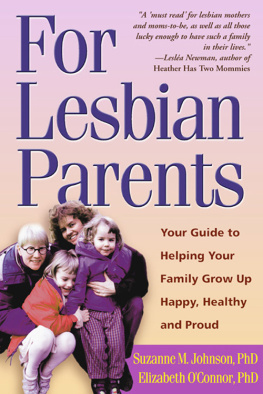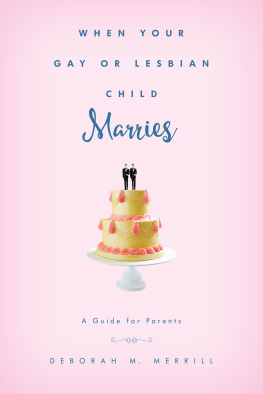
Lesbian Family Life, Like the Fingers of a Hand
In this book, an array of approaches - first person and theoretical accounts, clinical understandings, qualitative and quantitative research - are brought to bear on controversial or under-discussed topics in lesbian family life.
From conception all the way to care for elderly parents, this book takes a fresh look at lesbian family relationships. Topics include: butch/femme couples, infidelity, the psychological meaning of family for lesbians, age-discrepant couples, lesbian nuns as family, Listservs as family, intentional family for aging women, women raising sons, mothers who come out late in life, mothers and children in situations of domestic violence, lack of support for lesbian domestic violence survivors, death of a partner, psychological issues in the use of sperm donors or surrogates, and middle-aged lesbians caring for homophobic elderly parents. Some authors use self psychology and Jungian psychology to describe aspects of family life. The richness and diversity of topics makes it a text on lesbian lives.
Therapists and academics from throughout the U.S. have contributed to this collection. Many lesbian women, as well as teachers (who can use this book as a teaching aid) and mental health professionals who work with children, families, couples and elderly will find useful material here.
This book was published as a special issue of the Journal of Lesbian Studies.
Valory Mitchell received her Ph.D. in Psychology from the University of California, Berkeley, in 1983. She is a full professor in the Psy.D. Program at the California School of Professional Psychology at Alliant University, San Francisco Campus, where she has taught for over 20 years. She has been coordinator of the schools Gender Studies Emphasis Area, and director of its Institute for the Psychology of Women.
Lesbian Family Life, Like the Fingers of a Hand
Under-Discussed and Controversial Topics
Edited by Valory Mitchell
First published 2010 by Routledge
2 Park Square, Milton Park, Abingdon, Oxon, OX14 4RN
Simultaneously published in the USA and Canada
by Routledge
270 Madison Avenue, New York, NY 10016
Routledge is an imprint of the Taylor & Francis Group, an informa business
2010 Taylor & Francis
Typeset in Times by Value Chain, India
Printed and bound in Great Britain by CPI Antony Rowe, Chippenham, Wiltshire
All rights reserved. No part of this book may be reprinted or reproduced or utilised in any form or by any electronic, mechanical, or other means, now known or hereafter invented, including photocopying and recording, or in any information storage or retrieval system, without permission in writing from the publishers.
British Library Cataloguing in Publication Data
A catalogue record for this book is available from the British Library
ISBN10: 1-56023-770-8 (h/b)
ISBN10: 1-56023-771-6 (p/b)
ISBN13: 978-1-56023-770-9 (h/b)
ISBN13: 978-1-56023-771-6 (p/b)
Barbara Collier, the cover artist, has done over 200 pen-and-ink drawings of hands. In addition to her art, Barbara teaches death and dying, and is director of the Martin de Porres Foundation, which maintains hospice care, a house of hospitality, and a soup kitchen serving over 200 free meals each day in San Francisco. Pictured here is the hand of her daughter, Camilla.
CONTENTS
Valory Mitchell
Arlene Istar Lev
Beverly Burch
Diane Ehrensaft
Amy Weston
Jennifer L. Hardesty, Ramona Faith Oswald,
Lyndal Khaw, Carol Fonseca, and Grace H. Chung
Susan C. Turell and Molly M. Herrmann
Debra J. Broderick, Jean M. Birbilis, and Michael F. Steger
Susan Cayleff
Kristen Davies
Cindy M. Bruns
Jane Ariel
Mary Kay Hunyady
Valory Mitchell
Valory Mitchell
Lesbian identity does not follow the well-worn ruts in the conventional road that lead from sex to gender to gender-role to gender-of-partner. In the same way, our families cannot be neatly mapped according to a conventional family tree, where connections are established by law (as in marriage) or by genetic connections. Invisible through those lenses, our families have thrived nonetheless. And they are very visible now; same-sex marriage, the lesbian baby boom, and lesbian/gay families of choice are front-page news for some, old news for others, and have become just how it has always been for the generation of young lesbian women in their 20s. There was a time, not so long ago, when no one spoke aloud that another woman was a lesbian. Shes family, theyd say. It was closetcode, intended to keep us safely invisible to the straight community, yet identifiable to others like ourselves. An interesting choice for a code word. Why family? Perhaps it not only designated something we shared, but also hinted at a loyalty, an understanding, an inner circle.
Much has changed in a short time. Just over a decade ago, Laird and Green (1996) edited Lesbians and Gays in Couples and Families; they documented the important news that lesbians had families! The papers in that volume showed that many of us were closely connected to parents and siblings, had enduring marriage-like couple relationships, children (even grown children), extended family, in-laws, grandchildrenand, as well, the special families that we madeour families of choice. Today, the existence and richness of lesbian family life is no longer controversial; we, and the scholars who write about our lives, have established our presence.
One thing, however, has not changed: because most laws and institutions continue to penalize, exclude or ignore lesbian, gay, bisexual, and transgender (LGBT) people, we have the challenge and the opportunities that come from living outside them. We can, and must, decide for ourselves what we mean when we say family (Green and Mitchell, 2002).
Of course, just as we are a diverse lot, so our families will reflect our many cultures and contexts. There can no more be THE lesbian family than there could be one person who represents THE lesbian. Still, the relationships that make up our families are like the fingers on a hand. Each hand is unique; each finger has a separate name and does a particular set of things; yet they are naturally connected, need each other, and often work together to do things that none could do alone.
WHAT IS CONTROVERSIAL IN LESBIAN FAMILY LIFE?
When I announced the call for papers on under-discussed and controversial topics in lesbian family life, it occurred to me that the submissions could be imagined as data in a social psychology experiment. Taken together, this rich collectionof first-person accounts, theoretical and clinical papers, qualitative and quantitative researchbecomes the evidence that helps us articulate and define our ideas about lesbian family. Let us consider what is controversial (and why), what we do not (or rarely) talk about (and why), what we have stopped talking about because we take it for granted.
Feminist research methods (Stewart and Gold-Steinberg, 1990) and hermeneutic deconstruction techniques (Cushman, 2000) have taught us to look at silences, at those who rarely have a voice. By considering what is marginal as well as what is in the text about our families, we can see what has become an accepted part of lesbian family life, and glimpse those issues and themes that challenge us or make us uneasy. And we can confront the tasks ahead.






